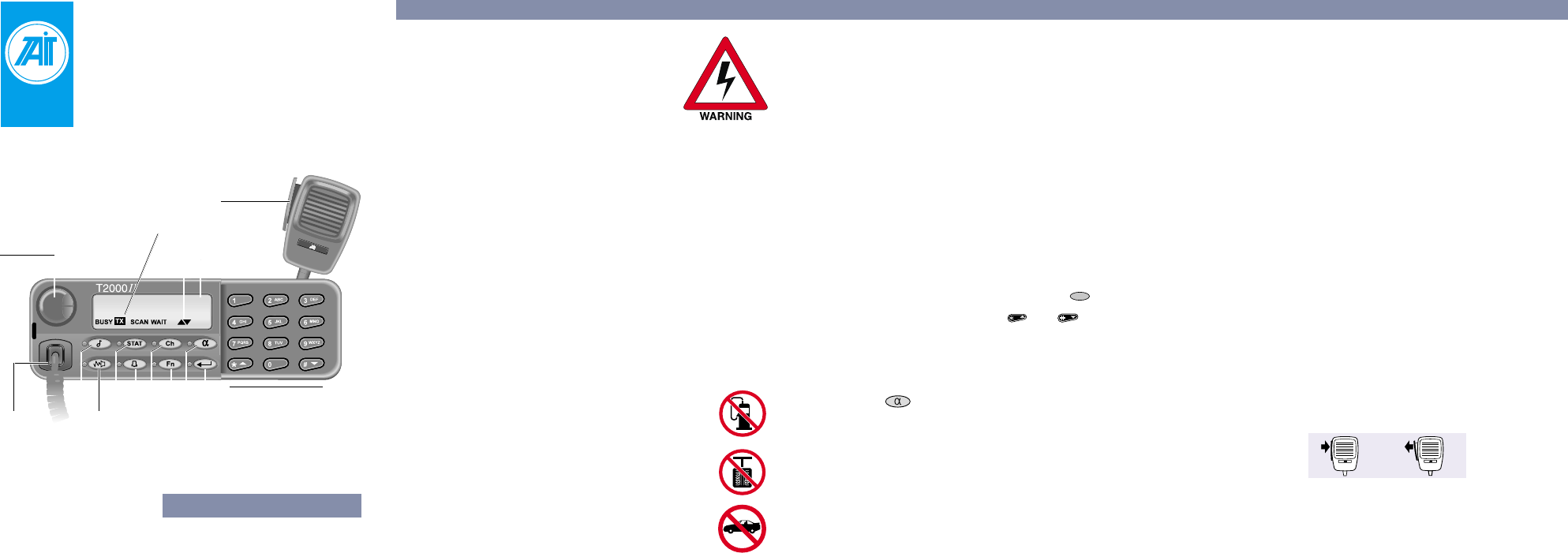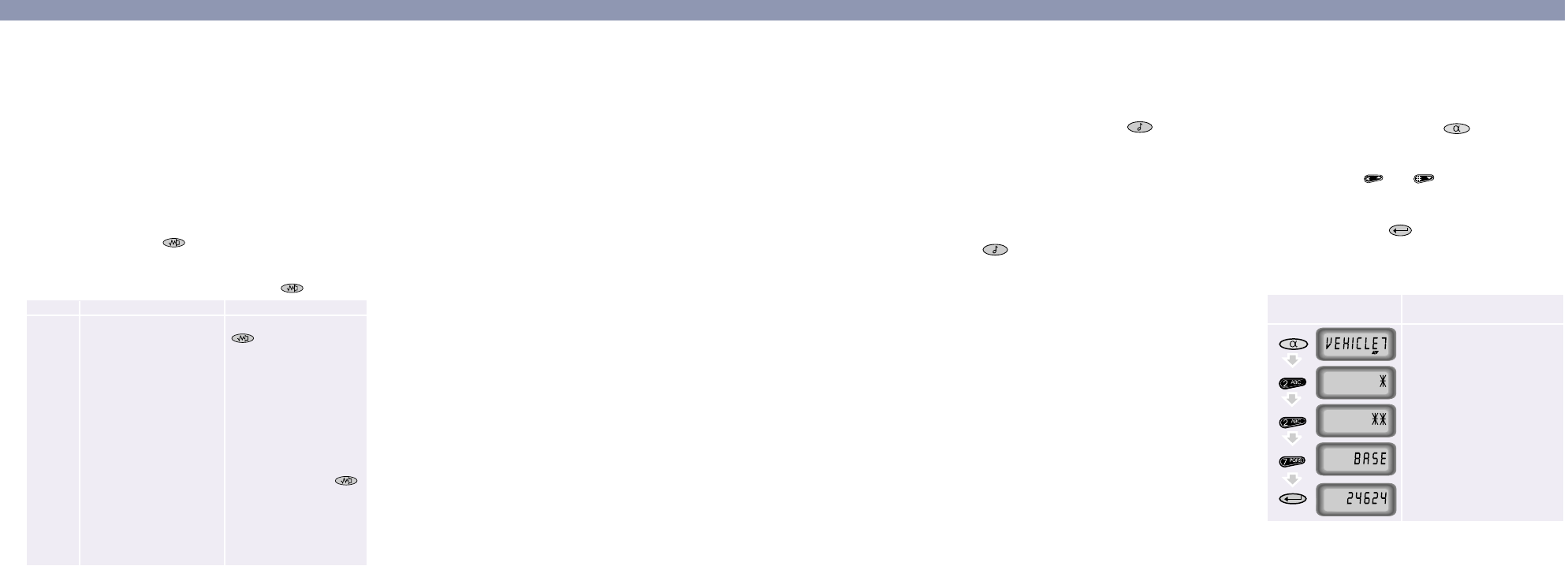Tait TEL0054 mobile transceiver User Manual T2020ugFCC p65
Tait Limited mobile transceiver T2020ugFCC p65
Tait >
Contents
- 1. Installation Guide
- 2. Installer and User information
- 3. amended user guide
- 4. amended installation guide
amended user guide

T2000
II
T2020II User’s Guide
T2020II
Call key
Status key
Microphone
socket
Auxiliary key
Monitor key
Function key
Channel key
Enter key
Alphanumeric key
ON/OFF - Volume
knob
PTT key
Keypad
Display window
Scrolling available
indicator
Transmit indicator
Safety Training Information
This product generates radio
frequency energy during
transmissions. This device must
be restricted to work-related use
in an occupational/controlled
exposure environment. The radio
operator must have control of the
exposure conditions and duration of all persons
exposed to the antenna of this transmitter to
satisfy FCC RF exposure compliance. This device
is not approved for general population use.
•It must only be used with authorized accesso-
ries and antennas.
•The operator must ensure that the minimum safe
distance of 0.9m (35 inches) between persons
and the antenna is not exceeded during
transmissions.
•Do not exceed a duty cycle ratio of 50% transmit
mode to stand-by or receive modes. The radio is
in transmit mode when the PTT key on the
microphone is pressed and the TX indicator
shows in the display window.
•DANGER: SWITCH THE RADIO OFF
AT PETROL FILLING STATIONS
•DANGER: SWITCH THE RADIO OFF
IN THE VICINITY OF EXPLOSIVE
DEVICES (such as in a quarry that
uses blasting techniques)
•Use of a handheld microphone or a
radio while driving could contravene
the legislation that applies in your
country or state. Please check the
vehicle regulations of your own
country.
Additional
Safety
Warnings
FCC RF
Exposure
Limits
Getting Started
Your T2020II is controlled by a microprocessor
which allows it to be configured to suit the needs
of your particular fleet.
This User’s guide provides only a brief description
of the basic features of your radio. For information
about the advanced features which may also be
provided, a comprehensive operators’ manual is
available from your Tait dealer.
To switch the radio on, turn the ON/OFF-
Volume knob clockwise about one-third of a
turn. You may need to finally adjust the volume
when you receive your first call.
When first switched on, the radio resumes
operation on the same channel as when it was
last switched off.
To check for activity on a channel, select channel
mode by pressing the Channel (
Ch
) key.
•Use the scroll keys ( and ) to move
through the list of available channels, or
•Use the keypad to enter a new channel number,
or
•Use the keypad to enter an alphanumeric label
().
A group is simply a collection of channels
grouped together for scanning or voting. You
select a group in the same way as selecting a
channel.
To Change
Channels
Switching
On
Selecting a
Group
Selecting a
Channel
Introduction
Making a Call
Sending a This section explains how to make a call using
Call your T2020II.
1Select the appropriate channel for the party you
wish to contact (see “Selecting a Channel”).
2Check that the channel is free of traffic by
observing the BUSY indicator - if it is illuminated
the channel is already in use and you must wait.
If your radio is preprogrammed for ‘off-hook
monitoring’ you will hear any other traffic when
you lift the microphone from its clip.
3Hold the microphone about 5cm from your
mouth and press the PTT key. Pause briefly to
ensure your first word is not cut off, then speak
clearly, identifying yourself and the person you
wish to contact by your call signs (for example
“Mobile-9 to Base”). Release the PTT key when
you have finished talking.
4When you receive a reply, proceed with your
conversation as described below.
Using the The PTT key on the side of the microphone
Microphone switches the radio between transmit and receive
and PTT key modes. Each time the radio transmits, the TX
indicator appears in the display.
To speak, press the PTT key and then release it
to listen to the reply.
Transmit The radio is fitted with a preprogrammed timer to
Timer limit the maximum length of transmissions. When
this time limit is reached, a three tone warning is
sounded and transmission stops. You must
release the PTT key before proceeding.

Alphanumeric Entry Mode
To perform repetitive operations which require
several keystrokes, your T2020II may be
preprogrammed with alphanumeric labels. These
labels, when recalled, can perform a series of
operations such as selecting a channel and
sending a call.
1Press the Alphanumeric ( ) key to enter
the Alphanumeric Entry mode.
2Scroll through the list of labels by using the
cursor keys ( and ) until the label is
displayed, or enter the label for the required
party, using the keypad.
3Press the Enter ( ) key to initiate the call.
You want to call your base despatcher who has
been assigned the label, BASE. The keystroke
sequence and display might appear as follows:
Scanning
To have your radio monitor a number of channels
for valid activity (transmissions carrying tones or
codes specific to you), you can use the prepro-
grammed scanning facility in your T2020II.
Scanning To set the radio scanning through a list of
preprogrammed channels:
1Ensure the microphone is in its clip (‘on-hook’),
2Select a group preprogrammed as a scan
group (see “Selecting a Channel”), and
scanning commences.
3If the radio detects a channel with valid activity,
it pauses there and makes the traffic audible to
you. When the traffic finishes, the radio
resumes scanning.
To stop the radio scanning, select another
channel.
While the radio is scanning, you may lift the
microphone off-hook to suspend scanning and
make a call.
If the radio was monitoring channel activity when
you lifted the microphone off-hook, then it remains
on that channel. If the radio was scanning for
traffic, then it returns to its preprogrammed ‘home’
channel.
Replace the microphone on-hook to restart
scanning.
Example
459-20200-03
Making a
Call While
Scanning
Selecting a
Sequence
Press
Key
Display
Reads Explanation
Most recent selection
displayed
Label not yet identified
Label not yet identified
New label identified
BASE is called and the
BASE number is displayed
Selcall Calls
Introduction If your T2020II is fitted with Selcall, you can
make calls to specific individuals or groups on
particular channels. For it to operate, your radio
must be fitted with the Selcall module and
preprogrammed appropriately. Each channel may
be preprogrammed to provide its own Selcall
identity immediately available with the Call ( )
key.
Sending a To call another party using Selcall:
Selcall Call 1Select the appropriate channel for the party you
wish to contact (see “Selecting a Channel”);
2Check that the channel is free of traffic by
observing the BUSY indicator;
3Press the Call ( ) key, or
•Dial the identity number using the keypad, or;
•Select an alphanumeric label for the call.
4When the person you call replies, lift the
microphone ‘off-hook’ and continue with the
conversation.
Receiving a When you receive a Selcall call, your radio alerts
Selcall Call you with a ringing sound (similar to that of a
telephone) and the CALL indicator appears in the
display.
•To accept the call, lift the microphone ‘off-hook’
and identify yourself in the usual manner. The
ringing stops when you press the PTT key.
•To reject a call, press any key other than the
PTT and the ringing will stop.
Group Calls If your radio sounds the ringing tone only once,
and the caller broadcasts their message without
waiting for a reply, you have received a group call.
It is not normally necessary to reply to such calls.
Receiving a Call
To be able to receive calls on a single channel,
simply check that the radio has the appropriate
channel selected (see “Selecting a Channel”).
To be able to receive calls on several channels,
see “Scanning”.
Responding Your radio remains muted until there is activity on
to Calls the channel. Listen for your own call sign, and
respond promptly when you hear it by pressing
the PTT key and identifying yourself (for example
“Mobile-9 Receiving”).
Monitor Your T2020II is fitted with muting facilities which
ensure you are not disturbed by calls which are
not clear or are not intended for you.
The Monitor ( ) key is used to override any
preprogrammed muting controls, and allows you
to hear all traffic on a channel. The following table
describes the use of the Monitor ( ) key.
CTCSS/
DCS
mute
Selcall
mute
RF
squelch
Function
Permits reception only if
a call carries an
inaudible tone or code
specific to your fleet or
group.
Permits reception only if
a call carries a special
tone sequence which
represents your identity
number.
Permits reception only if
a call has a signal above
a factory-set threshold.
This ensures that only
intelligible signals are
made audible.
To Defeat / Reactivate
Press the Monitor
() key briefly.
(If hookswitch monitor-
ing is preprogrammed,
lifting the microphone off
hook will have the same
effect.)
Press briefly again to
reactivate.
Hold the Monitor ( )
key for more than one
second.
Press briefly again to
reactivate.